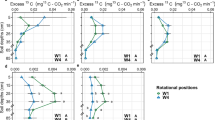Summary
Differences in growth responses of Douglas fir, western hemlock, Sitka spruce, and white spruce to nitrate and ammonium N sources were examined in sand culture and artificial soil culture. Effects of the two forms of N on growth, needle area, and N uptake of three Douglas fir halb-sib progenies were examined in a second sand culture. Response of Douglas fir to the two forms of N was followed over two years in nursery soil of different pH levels.
In sand culture 1 mean seedling dry weight of all species, except hemlock, was greatest when ammonium N and nitrate N were provided in equal amounts. In all species, except Sitka spruce, ammonium alone resulted in greater growth than nitrate alone. Use of ammonium N resulted in greater growth of all species, than was obtained with nitrate N, at pH values in the region 5.4 and 7.5 in artificial soil culture. Only Douglas fir showed substantial differences due to N source below pH 5. Growth of all species was greater at pH 5.4 than at 7.5 in each N source treatment.
Growth of Douglas fir seedlings was greatest with ammonium N and least with nitrate N in sand culture 2. Supply of nitrate and ammonium in equal proportions resulted in intermediate growth. Leaf area/plant weight ratio was unaffected by N source. Analysis of nutrient solutions showed appreciable nitrification of ammonium N during the 7 days between solution changes.
In the three greenhouse experiments, with little exception, increase in proportion of ammonium in N supply resulted in increase of seedling tissue N concentration. This effect was more pronounced in roots than shoots. Total N uptake by ammonium fed seedlings was about double the N uptake of nitrate fed seedlings in sand culture 2.
Nursery grown Douglas fir seedlings showed greater growth response to ammonium sulphate than to calcium nitrate, and this appeared due entirely to form of N supply in the first year. A similar response in the second year was partly due to greater soil acidification by ammonium sulphate. Compared with calcium nitrate, ammonium sulphate increased N concentration of one-year old shoots, but this difference was not detected by foliar analysis of two-year old seedlings.
Similar content being viewed by others
References
Barker, H., Methods of measuring leaf surface area of some conifers. Canada Dept. Forestry Rural Development. Forestry Branch Dept. Publ., 1219 (1968).
Benzian, B., Experiments on nutrition problems in forest nurseries. For. Comm. Bull.37, H.M.S.O. London (1965).
Durzan, D. J. and Steward, F. C., The nitrogen metabolism ofPicea glauca (Moench) Voss andPinus banksiana Lamb. as influenced by mineral nutrition. Can. J. Botany45, 695–710 (1967).
Evers, F. H., Die Bedeutung der Stickstofform für Wachstum and Ernährung der Pflanzen, insbesondere der Waldbäume. Mitt. Ver. Forstl. Standortsk. Forstpfl. Zücht14, 19–37 (1964).
Grasmanis, V. O. and Nicholas, D. J. D., Uptake of nitrate by Jonathan/MM 105 apple trees. Plant and Soil25, 461–462 (1966).
Greweling, T. and Peech, M., Chemical soil tests. Bull. 960. Cornell Univ. Agric. Exp. Sta., Ithaca, N.Y. (1965).
Hauck, R. D., Nitrogen source requirements in different soil-plant systems.In: Forest Fertilization, pp. 47–57. Symposium on forest fertilization. Gainsville, Florida (1968).
Ingestad, T. and Molin, N., Soil disinfection and nutrient status of spruce seedlings. Physiol. Plantarum13, 90–103 (1960).
Jordan, H. V. and Reisenauer, H. M., Sulfur and soil fertility.In: Soil, pp. 107–110. Year book of agriculture. U.S.D.A. Washington, D.C. (1957).
Leyton, L., The mineral nutrient relations of conifer seedlings with special reference to the phosphate relations ofPinus radiata D. Don. Anales Edaf. Agrobiol.36, 635–651 (1967).
McFee, W. W. and Stone, E. L., Ammonium and nitrate as nitrogen sources forPinus radiata andPicea glauca. Soil Sci. Soc. Am. Proc.32, 879–884 (1968).
Morrill, L. G. and Dawson, J. E., Patterns observed for the oxidation of ammonium to nitrate by soil organisms. Soil Sci. Soc. Am. Proc.,31, 757–760 (1967).
Overrein, L. N., Lysimeter studies on tracer nitrogen in forest soil: 2. Comparative losses of nitrogen through leaching and volatilization after the addition of urea-, ammonium- and nitrate-N15. Soil Sci.107, 149–159 (1969).
Swan, H. S. D., The mineral nutrition of Canadian pulpwood species. I. The influence of nitrogen, phosphorus, potassium, and magnesium deficiencies on the growth and development of white spruce, black spruce, jack pine, and western hemlock seedlings grown in a controlled environment. Pulp Paper Inst. Can., Tech. Rep.168 (1960).
Van den Driessche, R., Nursery experiments with Douglas fir. Commonwealth For. Rev.42, 242–254 (1963).
Van den Driessche, R., A comparison of growth responses of Douglas fir and Sitka spruce to different nitrogen, phosphorus, and potassium levels in sand culture. Can. J. Botany46, 531–537 (1968).
Van den Driessche, R., Growth analysis of four nursery-grown conifer species. Can. J. Botany46, 1389–1395 (1968).
Author information
Authors and Affiliations
Rights and permissions
About this article
Cite this article
Van Den Driessche, R. Response of conifer seedlings to nitrate and ammonium sources of nitrogen. Plant Soil 34, 421–439 (1971). https://doi.org/10.1007/BF01372796
Received:
Issue Date:
DOI: https://doi.org/10.1007/BF01372796




